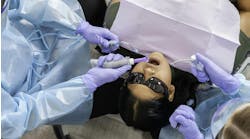Louis Malcmacher, DDS
In last month's article we explored whether or not a dental office should buy a laser. Let's take a similar look at CAD-CAM technology for your office. Let's be straightforward on this issue. I don't currently own a CAD-CAM system. I have worked hands-on with these systems at a number of dental offices, so I do have some minimal experience with this technology.
The most current and user-friendly CAD-CAM system on the market today is the CEREC 3 by Sirona Dental Systems. Many of you may not have recognized the Sirona name, but I can tell you that you will recognize the name Siemens Dental, which was bought out by Sirona circa 1999. Therefore, Sirona is not a new name to the dental industry, but it is built on the reputation that Siemens had for many, many years in the dental field.
So you will not be confused the way I was when I started looking at CAD-CAM systems, the CEREC 3 CAD-CAM system is made for the dental office, and CEREC InLab is a CAD-CAM system specifically designed for the dental laboratory. An optical impression is taken in the mouth, and then an inlay, onlay, or crown is milled from a single porcelain block in the machine, fitted into the mouth, stained, and cemented. In a laboratory setting, an optical impression is taken of the die and then either a full-porcelain restoration or a coping is milled in the machine.
Using a CAD-CAM system is "one-appointment" dentistry. One very important thing to understand is that the restoration is milled from a monochrome porcelain block, which means if you want to add stain and color, you've got to do this in the office yourself and it is done externally. This is a skill that some dentists have and most dentists would need to learn again. You still need to try-in the restoration, bond it into place, and adjust the occlusion accordingly. If it requires too much adjustment, you will lose some of the characterization that you spent time placing.
What do you save by using a CAD-CAM system? You save a number of things. You save having a second appointment with the patient, having to anesthetize again, the infection-control costs involved in setting up an operatory, the impression-taking, and the lab fee. In essence, you save time and money.
Now let's get down to the bottom line. A CAD-CAM system for your office is a very significant investment, usually approaching $100,000. Financing this kind of equipment at this point in time is very reasonable because interest rates are so low. But, should you get a CAD-CAM system for your office? The answer is, "it depends on you." There is a very significant learning curve associated with getting the most out of any CAD-CAM system. You will need to learn a whole new set of skills. This is not a negative, by the way. In order to make anything work in your office, whether it is one-hour whitening, veneers, or any other cosmetic dental procedure, all require a learning curve and an investment of your time, energy, and money.
If you choose to buy a CAD-CAM system, you better turn into a CAD-CAM dentist and really throw yourself and your staff into this technology to learn how to make its use the most beneficial for your office. But, if you think that just by buying the CAD-CAM unit and have it sitting in your office is going to make you money and increase your production, you will be sadly mistaken.
Ideally, you need to do the following analysis to see if you are ready for a CAD-CAM unit. Take a single porcelain crown, for example. Time yourself the next time you do one of these procedures, including all the time it takes you in the first and second appointments. Then go look at the CAD-CAM technology. Will you be able to accomplish the same procedure in one appointment in the same or less time than it took you in two appointments? After studying CAD-CAM and having an understanding of your own ability, if the answer to that question is yes, then the time is probably right for you to purchase a CAD-CAM unit.
New technology in dentistry is a rapidly evolving field. We are so lucky to be practicing dentistry with these advancements. It will only get better and better from here. Whether it is lasers or CAD-CAM, it is fun being a dentist in 2004.
Dr. Louis Malcmacher is an international lecturer and author known for hiscomprehensive and entertaining style.An evaluator for Clinical Research Associates, Dr. Malcmacher is a consultant to the Council on Dental Practice of the ADA. For close to two decades, Dr. Malcmacher has inspired his audiences to truly enjoy practicing dentistry by providing the knowledge necessary for excellent clinical and practice-management skills. His group dental practice has maintained a 45 percent overhead since 1988.For details about his speaking schedule, Dr. Malcmacher can be reached at (440) 892-1810 or via e-mail at [email protected].





